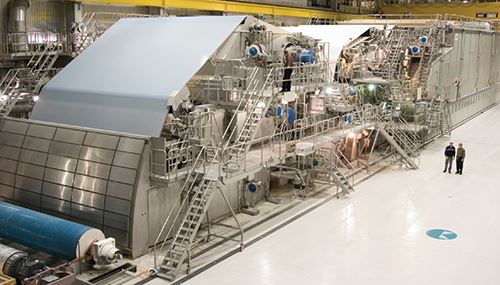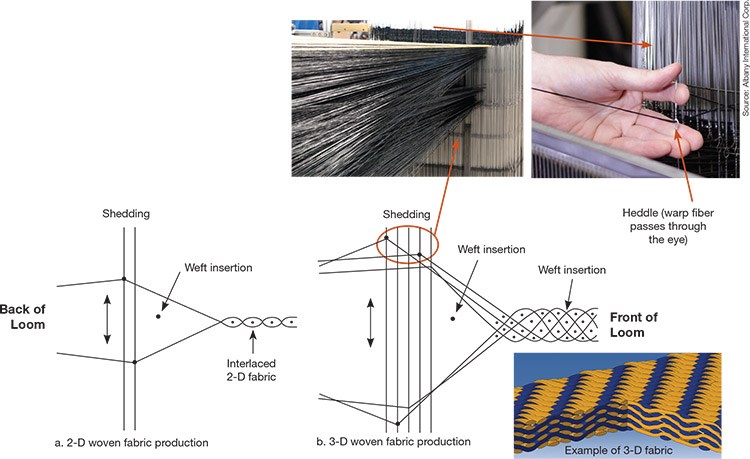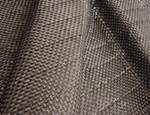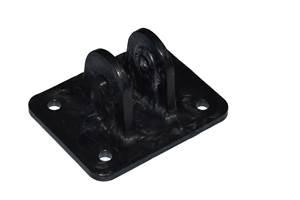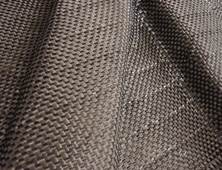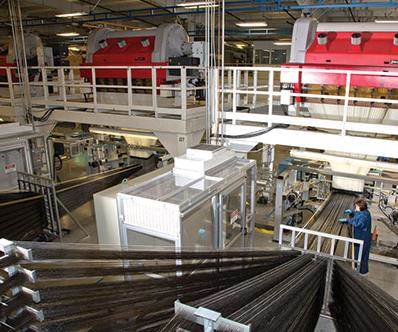Albany International: Multilayer to multidimensional
Albany International (Rochester, N.H.) has a half-century of experience in producing multilayer technical textiles to meet demanding performance and cost expectations.
Albany International (Rochester, N.H.) has a half-century of experience in producing multilayer technical textiles to meet demanding performance and cost expectations. The company earned its stripes weaving fabrics used as papermaking machine clothing — the highly engineered, custom-designed fabrics up to 12m/39-ft wide that are essential in multiple stages of paper production.
By the 1980s, multilayer fabrics had become prevalent in Albany’s machine clothing products due to the high tension and shear requirements in papermaking operations, such as calendering through heated rollers. Albany was a key innovator when the Jacquard-type looms used in weaving were transitioned from one-layer to three-layer fabrics to meet this need. For example, it developed the technology necessary to make seams in these massive fabrics with nearly the same strength as the base fabric but without imprinting the seam line onto the paper. Albany also helped pioneer automation of and improved control over the weaving process, including integrated process-data collection, automated fiber handling and error detection.
Multilayer fabrics have been woven on traditional 2-D weaving looms for some time. Familiar examples are webbing, belting and, as noted for Albany, papermaking fabric. These fabrics are produced by splitting the warp fibers (oriented in the direction of fabric production) to create multiple sheds (spaces through which the weft or filling fibers are inserted at right angles to the warp). If the warp ends are moved up or down during weaving (in Jacquard looms this is done using heddles, pictured at far right), then the fabric can be made to consist of several layers stacked vertically. Warp ends can be interlaced with fill fibers in the adjacent layer to produce layer-to-layer locked fabrics, or they can be interlaced with fill fibers in the top and bottom layers to create angle-interlocked fabrics.
Albany has established itself as the market leader in the competitive and now mature papermaking fabric market through continued R&D investment. Its subsidiary Albany Engineered Composites (AEC) has, in turn, built on this foundation, using the parent firm’s 50 years’ experience in textile process development to exploit the ability of the Jacquard weaving process to lift each single warp end — there are 8,448 in AEC’s current 3-D looms — either alone or in combinations, to create almost infinite possibilities for warp and weft patterns. AEC, thus, is pursuing the potential for 3-D textile preforms to help reduce the cost of unitized composite structures. AEC’s senior VP of business development, research and technology Brian Coffenberry concludes, “Just like Jacquards are currently used to create intricate patterns on mass-produced ties and carpets, we are using our innovations on this technology to create patterns through the thickness as well as on the surface, tailoring the structural properties of the 3-D composite and final structure.”
This short article is a sidebar to a feature article titled "Albany Engineered Composites: Weaving the Future in 3-D." To read the article, click on its title under "Editor's Picks," at top right).
Read more about 3-D wovens from 2-D looms in the “3-D woven reinforcements update,” under"Editor's Picks."
Related Content
Hybrid process marries continuous, discontinuous composites design
9T Labs and Purdue applied Additive Fusion Technology to engineer a performance- and cost-competitive aircraft bin pin bracket made from compression-molded continuous and discontinuous CFRTP.
Read MoreStitched, needle-punched fabrics benefit open and closed molding
CAMX 2024: Vectorply Corp. displays a range of engineered reinforcements, including NCFs, needle-punched reinforcements, consumables and more, along with highlighting it technical support options.
Read MoreUltra-light woven reinforcement fabrics enhance space-grade parts
CAMX 2024: TeXtreme is showcasing its TeXtreme 0/90 woven fabrics, demonstrated through customer Kerberos Engineering’s satellite solar array.
Read MoreTextile machinery, NCFs provide sustainable processing options
CAMX 2024: Karl Mayer is returning to CAMX with a focus on fabric- and fiber-handling equipment, in addition to its application development services.
Read MoreRead Next
3-D woven reinforcements update
Suppliers make progress toward reinforcement preforms that exhibit comparable properties in the x, y and z axes.
Read MoreAlbany Engineered Composites: Weaving the Future in 3-D
This 3-D weaver turned composite component supplier pursues a future in 3-D structures through continuous technology development.
Read More

